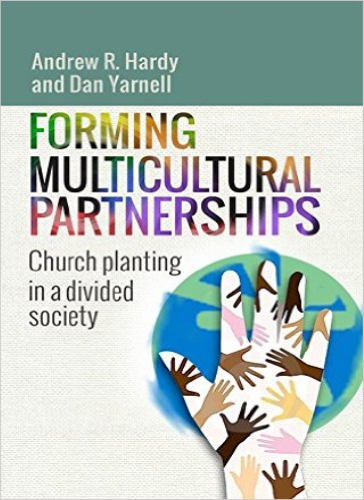Book Review: Forming Multicultural Partnerships
Hardy and Yarnell, Forming Multicultural Partnerships: Church Planting in a Divided Society, Instant Apostle: Watford, 2015
Hardy and Yarnell are both church planters and missional thinkers based in the UK, and their book clearly draws upon considerable practical experience as well as serious missiological and theological reflection. Forming Multicultural Partnerships covers many of the hot topics in missiology today – from ethnic churches to hospitality, and from missional church to reverse mission – all in relation to either church planting or partnerships between different churches.
The book is arranged into three main sections which can best be summarised as framing; training; and engaging. Part 1 sets the scene by providing data on religious affiliation and on ethnic identity, together with a panorama of the missional and emerging church movements in the UK today. The authors argue that contemporary Britain (with urban Britain especially in mind) is characterised by diversity; they not unreasonably suggest that traditional models of church are failing to reflect, or connect with, that diversity. This scene-setting is followed by a different type of ‘framing’, a theological one: the Triune God is identified as a “multicultural Trinity” that serves as a model for multicultural church and multi-ethnic congregations. Throughout the book, Hardy and Yarnell return to this theme of missio Trinitatis, rooted in the New Testament and Luke-Acts in particular.
This sociological and theological groundwork is important because it helps formulate some of the key missiological questions in Britain today: what should mission look like? And what should the church look like? Hardy and Yarnell passionately outline a model of “Trinity-shaped multi-ethnic missional communities.” Joining in God’s “multicultural kingdom” in this way will not be easy but worth overcoming the pain, for two reasons: we will have a fuller experience of true worship; and this experience will be an attractive witness to our increasingly diverse world.
Part 2 of Forming Multicultural Partnerships explores how the proposed model of church can be brought about through a combination of discipleship, cultural awareness, developing leaders and overcoming cross-cultural barriers. Given that each of these areas may present difficulties, successfully combining all four of them is clearly no easy task. There are some interesting thoughts from the authors here, such as missional multi-ethnic communities being mobile, with the image of the disciple as nomad and pilgrim; and the need for missional leaders to form “coalitions” that can help manage the process of change in congregations. A close-up study of Luke-Acts yields many precedents for the cross-cultural missional leader today, and solid advice on the need for flexibility, risk-taking and how to discern what is essential and what is fluid, or contingent on culture.
The third and final part of the book is somewhat disjointed and lacking in focus. The section is headed “Overcoming Obstacles to Engaging in Conversation” but the reader is taken on a tour of ‘neuro-theology,’ power theology, religious pluralism and comparative theology before arriving on surer footing in the final chapter. Here, we find five pragmatic ways of working towards multicultural mission and multi-ethnic churches. With no separate conclusion, the book ends rather abruptly, albeit on an optimistic note that encourages Christians to engage in multicultural mission to non-believers.
Overall, this is a well-researched book, which engages with much of the key missiological thinking in Britain over the last 50 years. The authors take care to say that there is no “one-size-fits-all” church solution and that monocultural churches should not (all) be disbanded – but their passion and preference for multi-ethnic churches is evident on every page. One may agree with this preference, however, while still acknowledging some of the limitations of this book
Firstly, the argument for multi-ethnic or multicultural churches is not fully established, either theologically or practically. If, as has been claimed, monocultural churches are more effective at attracting members of one ethnicity, by what criteria do we decide whether such effectiveness is more or less important than a theological preference for multi-ethnic churches?
Secondly, there are very few case studies in this book. Such examples would have not only have illustrated what multi-ethnic churches look like but would also have been evidence that they are plausible. The reader is encouraged to imagine “breakthrough” multi-ethnic churches but the imagination would be helped by demonstrations of successfully integrated churches in the UK.
There are other limitations too: little discussion of multi-ethnic churches in continental Europe, for example, and insufficient engagement with the perspectives of those actually leading ethnic or “non-Anglo” churches (though this may reflect a wider deficiency within missiology).
Overall, though, the book’s weaknesses are outnumbered by its strengths. Here is a timely and passionate plea for churches which are both more representative of Britain’s diverse cultures and simultaneously more representative of the “great multitude” that will constitute the heavenly People of God. There has been limited progress towards multi-ethnic churches in the 60+ years since the modern migration trend began in Britain. Hardy and Yarnell rightly question whether the time is now right for the overcoming of cultural barriers within the UK church and, moreover, offer hopeful yet credible suggestions for how this can be done. As such Forming Multicultural Partnerships will be of interest to church planters and missiologists alike.
Chris Ducker, Lecturer in Mission, Redcliffe College

